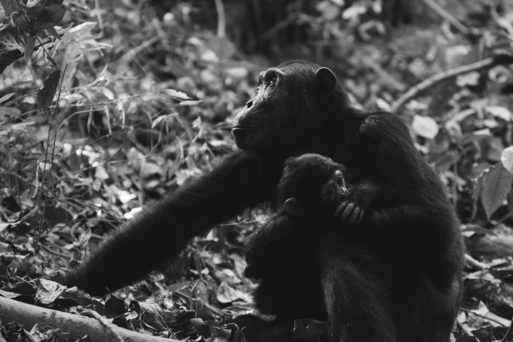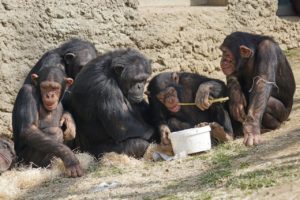 Chimpanzees are humans’ closest evolutionary relatives. Humans and chimps share roughly 99 percent of our DNA, and chimps display a wide range of emotions. It’s also possible that they mourn and grieve the deaths of relatives like we do.
Chimpanzees are humans’ closest evolutionary relatives. Humans and chimps share roughly 99 percent of our DNA, and chimps display a wide range of emotions. It’s also possible that they mourn and grieve the deaths of relatives like we do.
A study published in 2010 showed that chimpanzees are aware of death and can tell when one of their own is sick and dying. Led by primatologist James Anderson, a research team studied a group of chimps and their reactions to a dying relative.
Pansy was a 50-plus-year-old chimpanzee who lived in a Scottish safari park. In November of 2008 she became ill, and it was clear that she was nearing death. The head keeper at the park decided to let the other three chimps who lived there stay with her as she died. In the days leading up to her death, her companions became increasingly quiet and would move near her to sleep. They also groomed her meticulously, a sign that they were attempting to console her as she was dying.
After Pansy died, Chippy, an adult male who lived with her, appeared to test for signs of life by moving her limbs and closely inspecting her mouth. “When the adult male behaved as though he was testing Pansy for signs of life,” said Anderson, “it struck home that the chimpanzees might indeed have greater awareness of the difference between life and absence of life than we previously thought.”
It is impossible for researchers to truly understand why chimpanzees react to death in certain ways because they cannot talk to them. They can only observe and infer. For instance, Chippy at one point jumped and pounded on Pansy’s corpse. The researchers speculated that this could have been his attempt to resuscitate her. Or, it could have been the manifestation of his anger and frustration about her death. His mother, Blossom, groomed him afterwards, a behavior that may indicate consolation and support.
“We know that feelings of denial and anger toward the deceased are quite common elements in our own response to bereavement,” Anderson said. “It may be possible that Chippy was expressing something similar, in male chimpanzee fashion, with regard to Pansy.”
Passages from the report greatly detail the three surviving chimps’ reactions to the death of their comrade:
From the day area they watched silently as two keepers lowered Pansy from the platform, carried her into the exit corridor, placed her in a body bag, and loaded her into a vehicle that was then driven away. They remained subdued the following day as the night area was cleaned and disinfected, and new straw provided. When the connecting doors were opened Blossom and Rosie entered hesitantly, but Chippy refused; instead he showed fear grins and made loud alarm calls, causing the two females to quickly return to him.
The report continues to describe how the chimps “avoided sleeping on the deathbed platform for several days,” and did not touch places or objects associated with Pansy. This phenomenon reminds me of how people say they can sense when they’re in a room in which someone has died. The idea that you can get bad or eerie vibes from a place because someone had died there is strikingly similar to the chimps’ reluctance to be where their companion had died.
 Conclusions Are Difficult to Make
Conclusions Are Difficult to Make
Research and insight into the psyche of chimpanzees after the death of a fellow chimp is hard to come by. Most of the known research has been done on chimps in captivity. Scientists rarely get to witness chimpanzee death in the wild. One study on chimps in the wild, however, shows how mothers responded to the deaths of their infants.
A study out of Bossou, Guinea reported that two chimp mothers carried dead infants with them for varying lengths of time, even as the babies became mummified. The mothers cared for the corpses as if they were alive, swatting away flies, perpetually grooming them and allowing other chimps to interact with the bodies. However, the mothers carried the bodies by the limbs, which rarely occurs when infants are alive. This observation led the researchers to hypothesize that perhaps the mothers knew the babies were dead, but continued to care for them as a method to deal with their grief.
“I suspect that, at the very least, with time the mothers did gradually come to appreciate the finality of the situation more and more,” said Dora Biro, one of the researchers involved with the Bossou study. “Their persistence in holding on could have been a byproduct of the extremely strong bond that exists between chimpanzee mothers and their infants, a bond which, under normal circumstances, makes sure that the mother of a live infant never abandons it before it is ready to be independent. Or it could have been their way of dealing with the death.”
It is interesting to draw comparisons between human and chimpanzee reactions to death. Evolutionarily speaking, it’s easy to see how human feelings of anger, denial and eventually acceptance have become universal in our species. Similar reactions to death by our closest biological relatives makes the connection between our species all the more apparent. Many hospitals in the human world allow parents of deceased infants to remain with their child’s body for a significant amount of time before burial or cremation to aid the grieving process. Perhaps zoos should do the same for their primates.

 Chimpanzees Grieve Death Like Humans
Chimpanzees Grieve Death Like Humans


 John Mulaney’s “Funeral Planning” on Netflix: No Real Plan
John Mulaney’s “Funeral Planning” on Netflix: No Real Plan

 Composting Bodies Is Now Legal in a Dozen States
Composting Bodies Is Now Legal in a Dozen States














